A couple of Swiss conceptual artists are offering open air “hotel rooms” perfect for the summer.
Buzz60
“The woods are lovely, dark and deep . . .”
–“Stopping by Woods on a Snowy Evening by Robert Frost
The nighttime winter sky often shimmers with piercing, icy-like starlight. This isn’t an optical illusion. In the Northern Hemisphere, during the winter season, the Earth’s orbit directs us toward the edges of the Milky Way galaxy. The sky is darker; the stars appear brighter. In summer we’re directed more toward the Milky Way’s cluttered center. Cold air is also typically drier than warm air, which improves atmospheric clarity.
The winter woods sharpen human hearing, too. That’s because sound travels farther in cold weather.
Winter campers are well-acquainted with these delightful phenomena. They are why we retreat to the woods in winter. But they are hardly the only reasons.
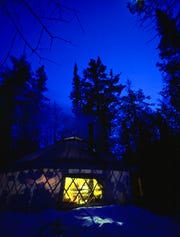
A yurt provides a cozy winter camp shelter and a view of a dazzling night sky on Minnesota’s Gunflint Trail. (Photo: Explore Minnesota)
Minnesota has its own brand of winter camping, which often includes a white landscape and bone-chilling temperatures; possible roadblocks for the faint-hearted but hardly deterrents for those well prepared, according to Alyssa Hayes, a senior public relations officer for Explore Minnesota.
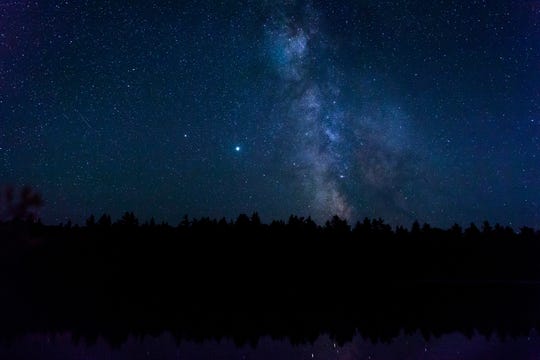
Minnesota’s Boundary Waters Canoe Area Wilderness, a Dark Sky Sanctuary site, offers spectacular views of the Milky Way. (Photo: John Zilka/Getty Images/iStockphoto)
“Winter camping in Minnesota is a one-of-a-kind experience, offering a serene, snow-covered landscape and primetime viewing of the darkest starry skies above” says Hayes, who noted that her state’s Boundary Waters Canoe Area Wilderness has been certified as the largest International Dark Sky Sanctuary by the International Dark Sky Association.
“With the correct gear, camping in the winter can be an out-of-the-ordinary, fun and refreshing adventure,” she says.
True. But it’s important not to arrive at camp with the sun setting and temperature dropping only to discover you’ve forgotten a critical piece of gear (like tent stakes or stove fuel). Avoid these unpleasantries by using a gear checklist. You can find gobs of them online, includes these thorough ones from REI and Switch Back Travel.
However, it’s best to hone your winter camping stash to individual needs and your specific destination. One general rule to follow, however, is it’s better to be overprepared than underprepared.
The formula for a safe, successful and fun trip is fairly simple: Stay warm. Stay well hydrated. Eat well. Eat smart. Eat often. And stay dry.
“For winter camping one of the most important things to remember is that, regardless of any specific kind of gear, it’s important to have multiple layers (of clothing), explains Hubner. “Layering your clothes helps with temperature management.”
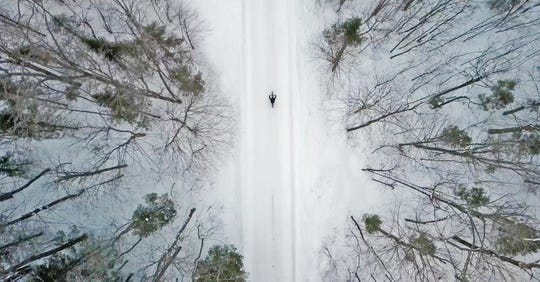
If you have a bike with tires that are fat and have enough tread, you can enjoy having the trails all to yourself. Just be sure you can change a flat. (Photo: Baffin)
The key here is to stay warm but not perspire. Even a thin layer of sweat can quickly chill you.
“You want to stay warm but should avoid sweating, explains Hubner. “Once you’re wet, if the temperature drops you can get much colder very quickly.”
Avoid cotton, which is notorious for holding moisture. I prefer wool for socks, hat and gloves and wool or a wool blend for both underlayer and outer garments.
Hubner says several of his company’s winter boots include a multilayer, removable insulated liner, allowing the layering strategy to be applied to feet. But regardless of which brand or style winter footwear you use in camp, teem them with wool socks. Warm socks are the last line of defense against cold, damp feet.
“For added warmth,” he says, “boots should be paired with wool socks.” Hubner’s preferred sock fabric is merino wool.
Few winter campers simply pitch a tent then stay in it. We hike. We fish. We birdwatch. We snowshoe. We cross country ski. We study the night sky.
To do these things you will need food. Lots of it. Stay warm and eati smart.
Winter camping: A legit reason to eat more
“Depending on your level and duration of activity it’s possible to burn twice the number of calories in a day then you might typically consume,” adds Hubner. “But for the recreational camper you should expect to burn an extra 30 to 40 percent of calories on average over the course of a full day winter camping.”
He recommends loading your cold camp menu with carbohydrates and electrolytes, as both provide quick energy and hydration. However, the menu need not be complicated.
“When in doubt, there is no better fuel for winter camping than soup,” he notes. “Soup can help keep your body warm, stay hydrated, replace electrolytes and supply calories.”
Trail mix (raisins, peanuts, etc.) – be it homemade or prepackaged – is another winter camp food staple to bring on your trips. “It’s a great snack to keep handy,” Hubner says. “Snacking throughout the day is very helpful when winter camping.”
There are plenty of dehydrated, prepackaged camp meals on the market. Some of the best I’ve tried are from Good To-Go. The menu is fairly varied, and prep is almost foolproof. Just add boiling water. They’re ready in about 10 minutes.
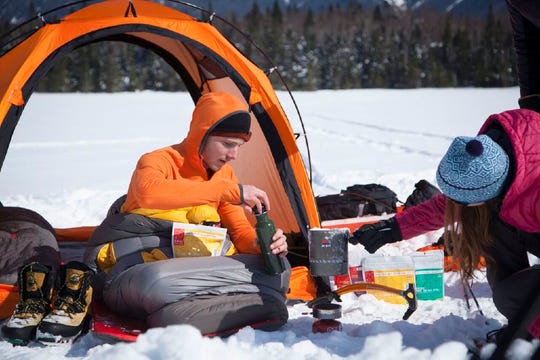
Dehydrated meals are your best friend on winter camping trips. Just add boiling water and wait 10 minutes. (Photo: Baffin)
Gear up
Your camp gear should be in good shape, clean and checked before you leave home. I prefer a liquid fuel stove for cold-weather camping, but canister type stoves are perfectly suitable.
There are numerous winter specific tents available. Choose one that fits your need and budget but pay special attention to the tent material and quality of the floor. Also, look for a tent with a vestibule and rainfly, which will help with condensation – which can be annoying in summer but is downright miserable in winter.
“The important materials or features to look for (in a tent) include ripstop nylon and a waterproof floor,” Hubner concludes. “Having a vestibule area for your boots and gear is very useful so you can protect them from the elements.”
Considering a camping trip? Tips to make sure your gear is good to go first
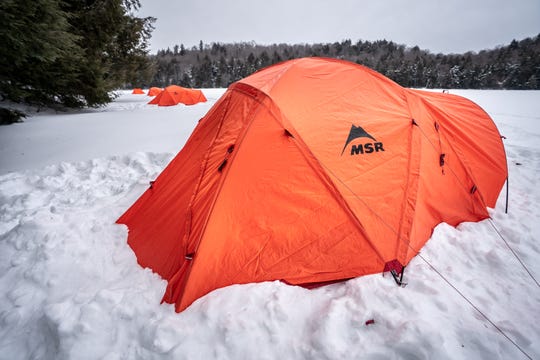
Make sure your cold-weather tent is snug and dry to keep the snow from creeping in. (Photo: Baffin)
Hayes adds that preparation is the key to a fun, safe and successful winter camp outing but acknowledges for first timers, it can be a bit intimidating, particularly for those lacking specialized gear.
“For those new to winter camping it can be challenging,” she says, suggesting that first-time cold weather campers consider working with a guide or outfitter or focus on destinations with camper cabins or yurts.
It is unknown how many of the 42 million or so recreational campers in the U.S., head out in the winter. But more should. It’s fun. It’s refreshing. It isn’t crowded. And there is no better way to social distance.
Read or Share this story: https://www.usatoday.com/story/travel/news/2020/12/26/cold-weather-camping-what-to-know/3958609001/

